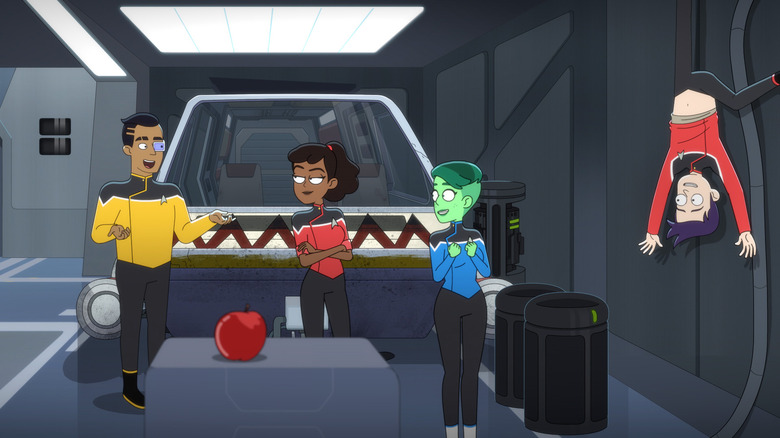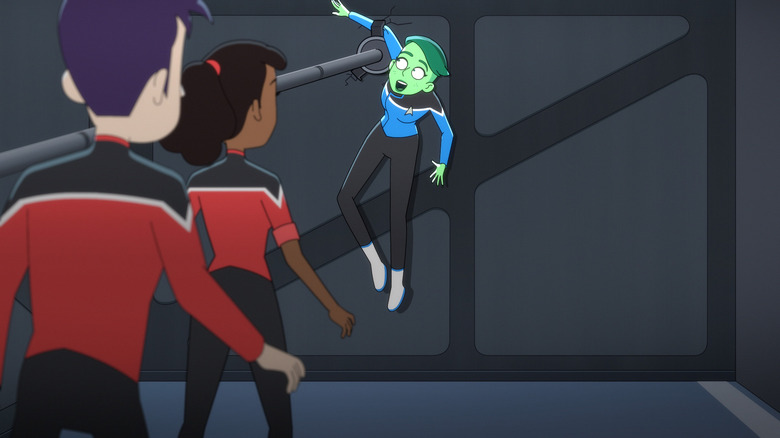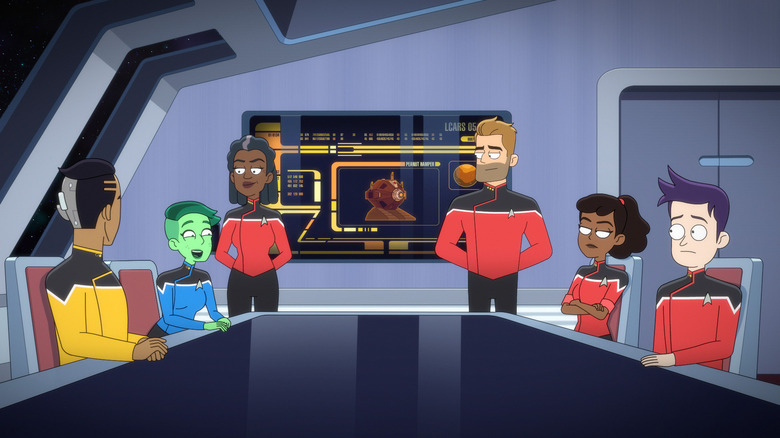Star Trek: Lower Decks' Biggest Meta Joke Yet Is A Tribute To The Franchise's Limitations
This post contains spoilers for season 4, episode 8 of "Star Trek: Lower Decks."
In the latest episode of "Star Trek: Lower Decks," called "Caves," lieutenants Boimler (Jack Quaid), Tendi (Noël Wells), Rutherford (Eugene Cordero), and Mariner (Tawny Newsome) — on the same away mission for the first time in a while — find themselves deep in the rocky, underground catacombs of a distant planet called Grottonus studying moss. Mariner whines about the mission, stating as soon as they beam down that she feels like she had been in that same cave a hundred times. Boimler considers his surroundings and notes that all caves, no matter the planet, kind of look the same. Tendi notes that all caves look the same because they're all made by ...
There is a small beat before she and Rutherford answer "soluble minerals" in unison.
Mariner's and Boimler's comments, of course, are a winking in-joke for Trekkies. The caves all look the same because, well, they are. Throughout "Star Trek" (at least from 1987 to 2005), cave scenes were filmed in what appeared to be the same two or three sets located in Stage 16 on the Paramount lot. And the cave sets were not, perhaps amusingly, constructed of actual rocks, usually giving off a papier-mâché or "rumpled butcher paper" vibe. There's even a line in "Lower Decks" pointing out how all caves have mysteriously flat, even floors, a common feature of "Star Trek" caves.
Instead of "soluble minerals," Tendi and Rutherford could have easily said "Paramount Television's set department."
And, to ensure that all of the "cave mission" clichés in "Trek" are in place, there's a tremor that traps the four main characters underground. Mariner rolls her eyes, knowing that thick rock always, without fail, interrupts their communicators, and just waits, impatiently, for some implacable horror to appear.
Stage 16
Of course, cave sets are a great cost-saving measure for a sci-fi TV show. One needn't spend any money on special effects, matte paintings, or alien superstructures when the characters are trapped in caves. As such, "Star Trek" has had many, many cave-based episodes in its history, making for what might be, even if we're generous, the least interesting visuals the franchise has to offer. One might recall Captain Kirk (William Shatner) lost in a cave in "What Are Little Girls Made Of?" (October 20, 1966) or fighting an acid-drooling lump-like cave monster in "Devil in the Dark" (March 9, 1967).
In the age of "Star Trek: The Next Generation," "Star Trek: Deep Space Nine," and "Star Trek: Voyager," Stage 16 was used as an access shaft to an underground medical facility, as Bajoran fire caves, as a Cardassian weapon storage, as the location of hidden monsters (that turned out to be hallucinations), as an underground spring, as a different underground spring, as the location of a computerized weapons system, and many others. Stage 16 was even used in two of the "Star Trek" movies, serving as the Rura Penthe prison colony in "Star Trek VI: The Undiscovered Country" and as the Ba'ku hiding place in "Star Trek: Insurrection." The cave sets allowed actors to walk only a few yards away to go to an alien world rather than having to shoot on location.
Indeed, there was an episode of "Deep Space Nine," "Heart of Stone" (February 6, 1995), whose A-plot was set almost entirely in a single cave room while Odo (René Auberjonois) tried to save Kira (Nana Visitor) from a shape-shifting rock that grew up around her body. That episode features very little action and even less visual variety.
Small Trek is better Trek
While cave episodes are typically pretty dull to look at and rarely provide stirring complex stories, they do highlight one of the franchise's most important credos: That necessity is the mother of invention. "Star Trek" has always, since time immemorial (at least in TV form), strained against its budgets. "Star Trek," of course, spends some money on special effects, starship exteriors, alien makeup, and animated phaser blasts, but to offset the expense, many episodes take place entirely on the ship or station. When one can only use the sets that have already been built, one has to get creative with character, dialogue, and story.
And it's when writers work with limited resources that "Star Trek" seems to become strongest. By reusing sets, showrunners are forced into familiar locations time and time again, which, in turn, allows viewers to feel like they, too, are living on a ship. After a while, Trekkies start to get the idea that they might be able to operate the conn themselves, or help Geordi La Forge (LeVar Burton) down in engineering.
And yes, caves will always provide a claustrophobic thrill, no matter what planet they're on. And caves can be made sinister, mysterious, or even monstrous through little more than dialogue. Just have a Starfleet officer look at their tricoder and say something like, "There's tritritium in these cave walls. We can't use our phasers in here." Boom. Plot point. Then mention that the Plognosians used to use these caves as evacuation tunnels during the 15th Rhesax War. Boom, rich history. All that without having to leave Stage 16.
"Lower Decks" in an animated show, but the cave-based low-budget charms of "Star Trek" were captured in "Caves."


